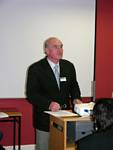
|
Home > About > Conferences > Galway 2007 > List of Papers > Abstract: King |
|
|
Adventurers, Emissaries and
Settlers:
Ireland and Latin America
Overview -
List of Papers -
Schedule -
Gallery |
|
|
Abstract The game of hurling among the Irish in Argentina 1890-1950 Seamus King (Ireland) The
paper explores the development of the game of hurling among
the Irish immigrants to Argentina in the 19th century. It
identifies the extent of that immigration and the counties
of origin of the settlers. A study of the county of origin
in Ireland of the settlers reveals Westmeath as the most
popular originating county with 42.9%.
This study was done by analysing two lists, Irish
Passengers to Argentina 1822-1929 and Irish Settlers in
Argentina. Wexford was the second most popular with 15.6%
and Longford third with 15.3%. The earliest references to
the game being played are from 1887/88 and they come from
Mercedes and near the Monastery of San Pablo, Capitán
Sarmiento. However,
the game wasn’t officially organised until 1900, and the
man credited with the organisation is William Bulfin
(1861-1910), a County Offaly man, who came to Argentina in
1884, the year the G.A.A. was founded. Bulfin was to do for
the sporting life of the Irish, what Fr. Fahy has done for
their social and economic welfare. He was also to give the
Irish community an identity: it was he who coined the term
‘Irish-Argentine’, and worked to separate the Irish from
the British in Argentina. It would appear that the first
official game was played on July 15, 1900 between Almagro
and Palermo, two districts in the city of Buenos Aires.
The teams were made up of nine players each due to
the limited number of hurleys available.
After another exhibition match the following month,
the Buenos Aires Hurling Club was formed and James P. Harte
became the first President. This club was practically and
formally, in William Bulfin’s own words, a branch of the
G.A.A. Clause 3 of its Constitution and Rules stated:
‘That the Buenos Aires Gaelic Athletic Association shall
be a strictly non-political and non-sectarian
association.’ Hurling
became a important expression of Irishness in Argentina and
allowed the Catholic Irish immigrants to differentiate
themselves from the surrounding community.
It helped to preserve the ethnic distinctiveness that
Archbishop Murray was afraid they were losing, when he sent
Fr. Fahy to be their chaplain.
The game declined somewhat during World War 1 but
revived and became quite strong in the twenties and the
thirties with as many as six teams competing for the
All-Argentine championship. Roman Catholic priests were to
the foremost in establishing clubs. Some of these priests
used their contacts in Ireland to promote hurling in
Argentine. In
the 1930s Fr. Vincent O’Sullivan, S.C.A. was given one
hundred hurleys and six sliotars (hurling balls) by the Cork
County Board G.A.A. for the boys of the Fahy Institute.
Thurles Sarsfields Club in County Tipperary sent hurleys to
Fr. Tony Kelly, S.C.A., an ex-member of the club, who
laboured for many years in Buenos Aires.
Fr. Pat O’Brien, born in Argentina, became a
skilful hurler while studying in Ireland. The game declined
during World War 2 with the drying up of the supply of
hurleys from Ireland. Also,
immigration from Ireland virtually came to an end. The
Hurling Club in Buenos Aires, which had been synonymous with
the game, gradually diversified into other games,
particularly hockey. The
Argentine team that represented the county in the 1952
Olympics, included former hurlers. As a Colombian educated in Among other subjects, the paper deals with the Irish legion (including its last
contingent, who did not serve - or mutiny! - in the
Guajira), the Rifles battalion (led by Arthur Sandes' Irish
officers), Bolivar's staff officers (two Irishmen - Daniel
O'Leary and William Ferguson - and an Englishman - Belford
Hinton Wilson) and |
|
|
|
|
|
Online
published: 24 April 2007 Edited: 07 May 2009 |
| The Society for Irish Latin American Studies |
Copyright Information |
|
